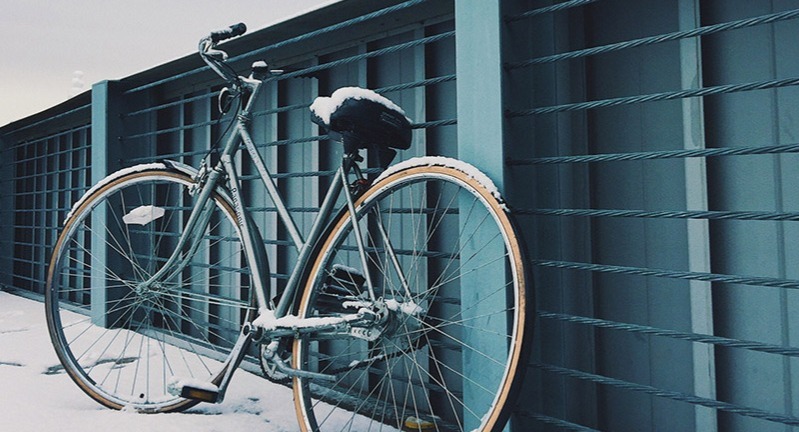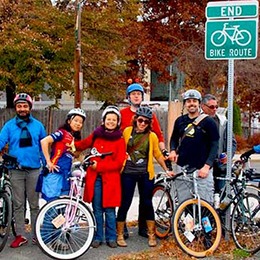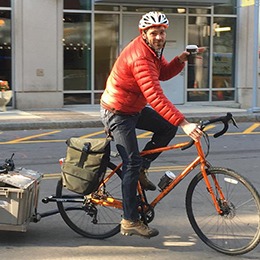WINTER COMMUTING TIPS
A few pointers to get you from point A to B
by Galen Mook
"Sometimes it's best to take control of your own mobility and use the mighty power of your own two legs"

Take charge of your commute
Getting around in the middle of winter can be tough. Cars are buried. Parking spots are used for snow storage. Sidewalks are slicker than ice rinks. Folks are waiting for the bus that never comes... Sometimes it's best to take control of your own mobility and use the mighty power of your own two legs and your bike's two wheels to get you from point A to B. Here are a few pointers to help you along the way.
Backup clothes
Firstly, you've got to make sure you have a way to warm up once you reach your destination. If you're concerned about arriving messy, which is shockingly easy when riding in the slush, think about carrying a change of clothes or stash a change at your destination. If you’re the kind of person who likes to freshen up once you arrive, a good trick is to have a set of baby wipes handy. Are you biking to work or class, a meeting, or appointment? Take some time to practice the “clothing changeover” to see what works best for you. Plan to get there a bit early, just to acclimate to being indoors, and so you don’t arrive with a red face and ice melting from your hair!
Winter darkness
As the days get shorter and the clouds roll in, visibility is limited out on the roads. So it’s always a good idea to have a few sets of lights on your bike and/or body when riding. Every state is different, and the legal minimum in Massachusetts is to have at least a front light and rear reflector, but really that’s not enough in a dark winter’s evening. Be sure to wear reflective gear to catch the eye of driver. And have a powerful light for seeing, as well as a lesser blinking light for being seen. There’s no limit to how much lighting your bike can have, so feel free to go wild, and channel your inner Christmas tree to brighten up the night.
Changing routes
Riding in an inch or two of snow shouldn't be a problem, but once the snow starts to accumulate you may need to choose alternate routes based off how active the snow plows are. Some roads have a higher priority for clearing, and they're likely to be the more trafficked and busier routes. If you're used to taking the bike path, or even the on-street bike lanes, keep in mind most bikeways are cleared last (if at all), and that may put you out on the roads mixing with traffic. That means you will have to ride in the line of traffic and be predictable. Be sure to signal all your turns, and over communicate with your gestures and lights so drivers know you are there!
And be aware of the changes in the pavement. Deep freezes, followed by daytime melting, will lead to potholes—those dreaded eaters of wheels! You've got to keep your eyes on the road and expect worsening roads in the winter. Not all roads are created equal, so choose your journey wisely.
Riding in traffic
Don’t forget that car drivers have a tough time in winter as well. Their visibility is limited due to foggy windows, and ice and snow on the mirrors and glass. So be predictable and don’t assume you are seen out there. A mantra of some cyclists is to “ride as if you’re invisible,” that is: no one automatically sees you. Don't be a ninja. Be as bright and prominent a presence as possible. This means reflective clothing and lights, signaling with hands and eye-contact, and riding defensively until you're sure the driver has acknowledged that you are sharing the road with them.
And just as bikes take longer to stop and sometimes slip on turns and when accelerating, so do cars! Don’t cut it close, and be prepared for unexpected movements from large vehicles. This means: give as much space as possible, and ride with the traffic and not squeezed in alongside moving vehicles and the curb.
Parking + locking up
Be nice to your bike and bring it inside! If you can find a mud room or a large indoor space where you can drip dry, that’s best. If you’re concerned about making a mess, have a large towel or tray under the bike to catch the melting snow, salt, sand, and grit.
To protect your saddle during an active snowfall, you can purchase a quality seat cover to keep your seat nice and dry. Or if you’d like the cheap method, try a plastic bag! You can tie the bag to your saddle rails when its not in use, or put it in your saddle bag, so you’ll always have it handy.
If you’re out and about, be extra careful where you park your bike on the sidewalk. You never know when a slow plow or sidewalk brusher will come by and claim the space taken by your bike. In order to not get plowed in (or a bent wheel), be sure to keep your bike out of the way of pedestrians and plows. And, as always, never park in a handicap accessible zone or by a fire exit!
Carry along
Pack your bag with a few extra items to make your trip more comfortable.
- Tissues – for cleaning your nose
- Clean rag – for cleaning your bike, especially the brakes and rims
- Lip balm
- Extra batteries – for your lights (even an extra set of lights)
- Extra tube and pump – forget about fixing a flat in the cold/wet!
- Multi-tool, and the know-how to use it
- Seat cover – protect saddle from the elements when parked outside
Be multimodal
And remember, you don't have to always ride every time. Most public transit buses will have bike racks, including all MBTA buses in the Boston metro region. This allows you to be a part-way commuter if the weather turns nasty during the day.
Taking the bus is an alternative to riding in the mess. Just be sure you know how to operate the bike rack; many transit authorities have detailed How-To instructions on their websites, such as the MBTA website regarding bicycles.
Everyday Biking Tips
by Galen Mook
Galen Mook formerly worked in Landry's marketing department, and he is now MassBike's executive director. Galen is a year-round bike commuter, experienced cycling instructor, and community advocate for better bicycling.



